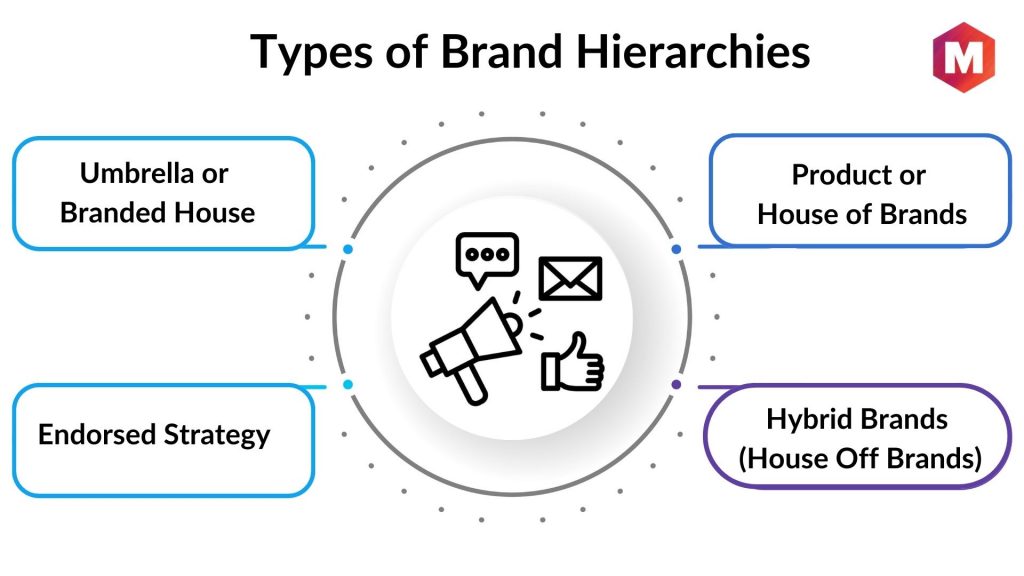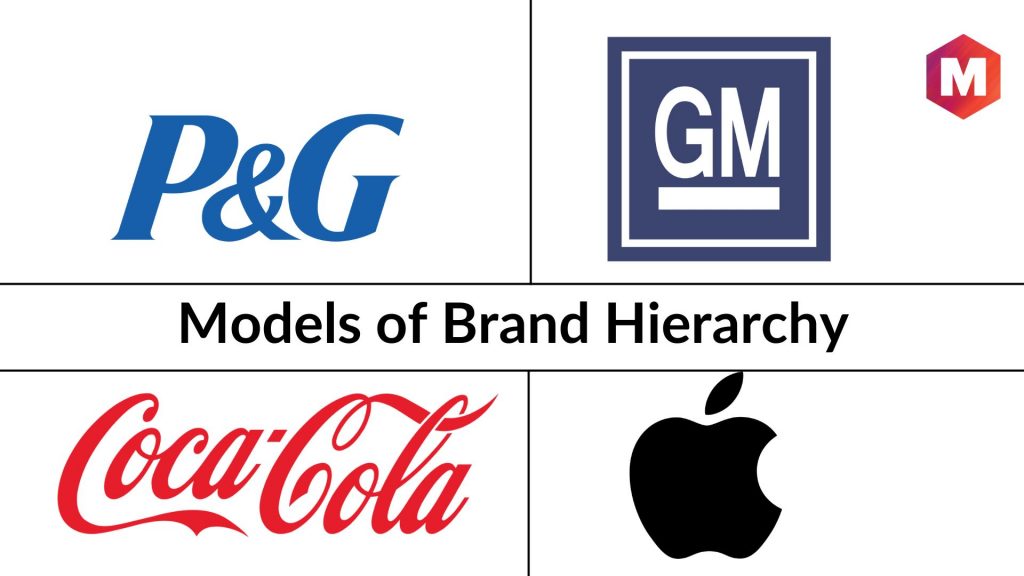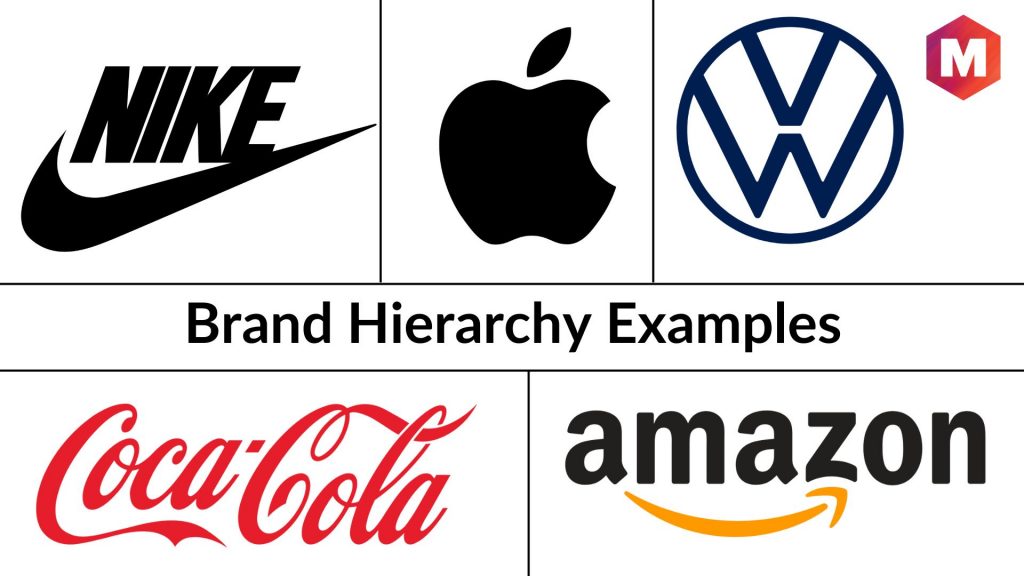Table of Contents
What Is Brand Hierarchy?
Brand hierarchy is the organizational structure of a company’s brand portfolio. It outlines the relationships between a brand’s different elements, and how they are positioned in the market.
The purpose of brand hierarchy is to create clarity and understanding within an organization about how its brands relate to each other, and ultimately, to the company itself.
The brand hierarchy is a strategy that conglomerates businesses’ parts and processes to make it easier for the market to identify their products and services. Companies categorize based on their unique elements, business owners use this strategy to help marketing easily understand what they are offering.
It is also known as brand architecture. With the help of brand hierarchy strategies, businesses can control how their brands are perceived in the market, and by extension, how customers perceive them. Brand hierarchy can be used to create a clear and distinct identity for each brand in the company’s portfolio. It can also be used to communicate the company’s overall brand strategy.
In a brand architecture structure, the parent brand is the main, overarching brand that includes all the products and services under its umbrella. The sub-brands are the brands that fall under the parent brand.
Most companies have a current brand structure in place. This is the way that their brands are currently organized. Brand hierarchy strategies help companies to change their brand structure in a way that is more efficient and consistent with their overall brand identity as well as separate brand identity.
Types of Brand Hierarchies
1. Umbrella or Branded House
An umbrella brand, also known as a branded house or family brand, is a type of branding strategy. Under this strategy, a single name is used for all products in a product line.
The main benefit of using an umbrella brand is that it can create economies of scale, as well as increase brand awareness and product recall.
Umbrella branding can also help to build customer loyalty, as customers who are satisfied with one product are likely to try other products in the same range.
2. Product or House of Brands
A product brand, also known as a house of brands, is a type of branding strategy. Under this strategy, each product in a product line is given its name.
The main benefit of using a product brand is that it can create a more premium image for the products, as each one is seen as a separate entity.
Product branding not only aids in building customer loyalty, but customers who are satisfied with one product from a certain range are also likely to try other products under the same brand.
3. Endorsed Strategy
An endorsed brand is a type of branding strategy. Under this strategy, a company’s name is used in conjunction with the product or service.
The main benefit of using an endorsed brand is that it can create a more premium image for the products, as they are seen as being endorsed by the company.
This brand hierarchy is ideal for sub-brands that aren’t large enough to survive on their own. Under this system, your sub-brands are still connected to the parent company and can therefore continue receiving support from it.
4. Hybrid Brands (House Off Brands)
A hybrid brand is a type of branding strategy. Under this strategy, a company’s name is used in conjunction with the product or service.
The main benefit of using a hybrid brand is that it can create a more premium image for the products, as they are seen as being endorsed by the company.
You can merge all of the aforementioned brand hierarchy elements to make your own. If the brand or company you want to partner with doesn’t match your current branding structure, this strategy is ideal.
Brand Hierarchy Levels
1. Corporate Brand
The corporate brand is the highest level in the brand hierarchy. It represents the overall identity of the company.
A corporate brand can be made up of several different elements, including the company name, logo, and tagline.
The corporate brand is usually the first thing that comes to mind when people think of the company.
2. Family Brand
A family brand is a sub-brand of the corporate brand. It represents a specific product line or range that the company offers.
Family brands are usually given their name, logo, and identity. They are often seen as separate entities from the corporate brand.
3. Individual Brand
An individual brand is a sub-brand of the family brand. It represents a specific product within the product line.
Individual brands are usually given their name, logo, and identity. They are often seen as separate entities from both the corporate brand and the family brand.
4. Product Modifier And Descriptor
A product modifier is a sub-brand of the individual brand. It represents a specific variation of the product.
Product modifiers are usually given their name, logo, and identity. They are often seen as separate entities from both the corporate brand, the family brand, and the individual brand.
A product descriptor is a type of product modifier. It is a sub-brand of the individual brand that represents a specific feature or characteristic of the product.
Product descriptors are usually given their name, logo, and identity. They are often seen as separate entities from both the corporate brand, the family brand, and the individual brand.
Importance Of Brand Hierarchy
1. Prevents Customer Confusion
If you have a clear brand hierarchy, it will prevent customer confusion. Customers will know exactly what product or service they are getting from your company.
There will be no confusion about what is included in the product or service, and customers will know exactly what to expect.
2. Helps Future Business Planning
A clear brand hierarchy can help you plan for the future of your business. You will know exactly which products or services you want to offer, and you can easily add new products or services to your lineup.
You will also know which products or services are doing well, and which ones need to be improved.
3. Attracts Focused Attention
When you have a clear brand hierarchy, it will attract focused attention from customers and prospects. They will know exactly what your company offers, and they will be able to easily find the products or services they are looking for.
This focused attention can help you increase sales and grow your business.
4. Provides A Clear Overview
Brand hierarchy provides a clear overview of your company’s products and services. It can help you understand what your company offers, and it can help you see where there is room for improvement.
Brand hierarchy can also help you create new products or services that are in line with your company’s identity.
Overall, brand hierarchy is important because it prevents customer confusion, helps future business planning, attracts focused attention, and provides a clear overview. All of these things can help you grow your business.
If you want to create a successful branding strategy, you need to make sure you have a clear brand hierarchy.
Models of Brand Hierarchy
1. Procter & Gamble Model
The Procter & Gamble model is a common model of brand hierarchy. In this model, the corporate brand is at the top, followed by the family brand, the individual brand, and finally, the product modifier or descriptor. The corporate, family, individual, and descriptors elements of the Procter & gamble model are-
2. General Motors Model
The General Motors model is similar to the Procter & Gamble model, but the order is reversed. In this model, the product modifier or descriptor is at the top, followed by the individual brand, the family brand, and finally, the corporate brand.
3. Coca-Cola Model
The Coca-Cola model is a bit different from the other models. In this model, the corporate brand and the family brand are at the top, followed by the product modifier or descriptor, and finally, the individual brand.
4. Apple Model
The Apple model is similar to the Coca-Cola model, but the order is reversed. In this model, the individual brand is at the top, followed by the product modifier or descriptor, and finally, the corporate brand and the family brand.
How To Create A Brand Hierarchy?
1. Discover which product groups you belong in
The first step to creating a brand hierarchy is to identify which product groups you belong in. There are many different ways to group products, but some common methods include by use, by price, or by the target market.
Once you have identified which product groups you belong to, you can start to determine your levels.
2. Determine your levels (Principle of Simplicity & Principle of Clarity)
The second step is to determine your levels. There are two main principles you should keep in mind when determining your levels: the principle of simplicity and the principle of clarity.
The principle of simplicity states that you should keep your levels as simple as possible. This means you should only have as many levels as you need to communicate your message.
The principle of clarity states that your levels should be clear and easy to understand. This means each level should be distinct and have its own unique identity.
3. Create the brand for each level (Brand Elements, Principles of Commonality & Marketing Strategies)
The third step is to create the brand for each level. This includes developing your brand elements and marketing strategies.
Brand elements are the visual and verbal components that make up your brand. They include things like your name, logo, tagline, and color scheme.
The principles of commonality state that your brand elements should be consistent across all levels of your hierarchy. This means using the same name, logo, and tagline at each level.
Your marketing strategy will vary depending on which level you are branding. For example, your corporate brand might be marketed through traditional advertising, while your product brands might be marketed through social media.
Here is a video by Marketing91 on Brand Hierarchy.
Brand Hierarchy Examples
1. Nike Brand Hierarchy
Nike is a perfect example of a company that uses a brand hierarchy. Nike has four levels in its hierarchy: the corporate level, the product level, the endorser level, and the consumer level.
At the corporate level, Nike’s brand elements include its name, logo, tagline (“Just Do It”), and color scheme (black and white). Their marketing strategy at this level is focused on traditional advertising.
At the product level, Nike has several different brands, each with its own unique identity. For example, the Air Jordan brand is targeted toward basketball players, while the Nike Free brand is targeted towards runners.
At the endorser level, Nike has several high-profile athletes that endorse their products, such as LeBron James and Tiger Woods.
Finally, at the consumer level, Nike’s target market is athletes of all levels, from professional to amateur.
2. Coca-Cola Brand Hierarchy
Coca-Cola is another company that uses a brand hierarchy. Coca-Cola has three levels in its hierarchy: the corporate level, the product level, and the consumer level.
At the corporate level, Coca-Cola’s brand elements include its name, logo, tagline (“The Real Thing”), and color scheme (red and white). Their marketing strategy at this level is focused on traditional advertising.
At the product level, Coca-Cola has several different brands, each with its own unique identity. For example, Diet Coke is targeted toward people who are looking for a low-calorie option, while Coca-Cola Zero is targeted towards people who are looking for a zero-calorie option.
Finally, at the consumer level, Coca-Cola’s target market is people of all ages who are looking for a refreshing beverage.
3. BMW Brand Hierarchy
BMW has four levels in its hierarchy: the corporate level, the product level, the sub-brand level, and the consumer level.
At the corporate level, BMW’s brand elements include its name, logo, tagline (“The Ultimate Driving Machine”), and color scheme (blue and white). Their marketing strategy at this level is focused on traditional advertising.
At the product level, BMW has several different brands, each with its own unique identity. For example, the BMW M brand is targeted toward performance enthusiasts, while the BMW I brand is targeted towards people who are looking for a more environmentally-friendly option.
At the sub-brand level, BMW has several different sub-brands that target different markets. For example, the BMW X5 M is targeted toward families, while the BMW M3 is targeted towards enthusiasts.
Finally, at the consumer level, BMW’s target market is people of all ages who are looking for a high-quality vehicle.
4. Apple Brand Hierarchy
Apple has four levels in its hierarchy: the corporate level, the product level, the sub-brand level, and the consumer level.
At the corporate level, Apple’s brand elements include its name, logo, tagline (“Think Different”), and color scheme (white and silver). Their marketing strategy at this level is focused on traditional advertising.
At the product level, Apple has several different brands, each with its own unique identity. For example, the iPod brand is targeted toward music lovers, while the iPhone brand is targeted towards people who are looking for a more versatile smartphone.
At the sub-brand level, Apple has several different sub-brands that target different markets. For example, the iPhone 14 is targeted towards people who are looking for the latest and greatest iPhone, while the iPhone SE is targeted towards people who are looking for a more budget-friendly option.
Finally, at the consumer level, Apple’s target market is people of all ages who are looking for high-quality and innovative products.
5. Amazon Brand Hierarchy
Amazon has four levels in its hierarchy: the corporate level, the product level, the sub-brand level, and the consumer level.
At the corporate level, Amazon’s brand elements include its name, logo, tagline (“The Everything Store”), and color scheme (orange and white). Their marketing strategy at this level is focused on traditional advertising.
At the product level, Amazon has several different brands, each with its own unique identity. For example, the AmazonBasics brand is targeted toward people who are looking for budget-friendly options, while the Amazon Prime brand is targeted towards people who are looking for free shipping and other Prime benefits.
At the sub-brand level, Amazon has several different sub-brands that target different markets. For example, the Amazon Fire TV is targeted toward people who are looking for a streaming device, while the Amazon Kindle is targeted towards people who are looking for an e-reader.
Finally, at the consumer level, Amazon’s target market is people of all ages who are looking for a convenient and easy way to shop online.
Conclusion!
There are many different ways to structure a brand hierarchy, and the right approach depends on the specific goals and needs of the company.
A well-designed brand hierarchy can help simplify the decision-making process, improve customer recognition and loyalty, and ultimately drive sales. When done correctly, a brand hierarchy can be a powerful tool for any business.
Do you have a question about brand hierarchies? Leave a comment below and we’ll do our best to answer it!
Liked this post? Check out the complete series on Branding


